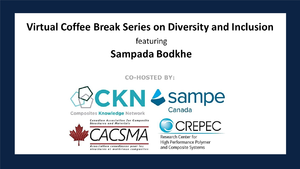D&I featuring Sampada Bodkhe - A352
| D&I featuring Sampada Bodkhe | |
|---|---|
| Perspectives article | |

| |
| Document Type | Article |
| Document Identifier | 352 |
|
Webinar Date
Featuring
Sampada Bodkhe
| |
Introduction[edit | edit source]
In this series of virtual coffee breaks, we discuss a variety of subjects related to Diversity and Inclusion (D&I). Topics will include the importance of D&I, mentorship, allyship, how to make your workplace more inclusive, unconscious bias, and more. Everyone is welcome to join.
In this session, Dr. Bodkhe, an Assistant Professor in the Department of Mechanical Engineering at Polytechnique Montreal, leads a discussion on EDI Perspectives From Both Ends. “As an early career researcher from underrepresented and visible minorities group, I would like to share my experiences with EDI, from being part of a group and now leading a group,” explains Dr. Bodkhe. “I will present some of the policies/actions from leaders that worked in favor of increasing equity and inclusion and those that did not.”
Biography[edit | edit source]
Dr. Sampada Bodkhe received her PhD from Polytechnique Montreal in 2017, where she developed piezoelectric inks and a technique to co-fabricate electrodes with piezoelectric sensors via co-extrusion based 3D direct-write technique. The research on the development of these self-powered sensors towards aero-elastic and biomedical applications was chosen as the 10 Best Discoveries of the Year 2018 by Quebec Science Magazine. As a visiting PhD student at the Organic robotics laboratory, Cornell University, she worked on SLA based 3D printing of highly flexible actuators.
After her PhD, she worked at Composite Materials and Adaptive Systems Laboratory at ETH Zurich, on establishing competencies in 3D printing of adaptive systems, multifunctional materials and structures. Prior to her PhD, she worked as an Edison Engineer at General Electric aviation, India on structural and thermal evaluation of components for LEAP 1B engines. She holds a master’s degree in Aerospace Engineering from Indian Institute of Technology Kanpur, India and a bachelor’s in Mechanical Engineering from Visveswaraya Technological University, India. She has keen interests in building an additive manufacturing platform for the fabrication of intelligent composite structures.
Video[edit | edit source]
| About | Help |
Welcome
Welcome to the CKN Knowledge in Practice Centre (KPC). The KPC is a resource for learning and applying scientific knowledge to the practice of composites manufacturing. As you navigate around the KPC, refer back to the information on this right-hand pane as a resource for understanding the intricacies of composites processing and why the KPC is laid out in the way that it is. The following video explains the KPC approach:
Understanding Composites Processing
The Knowledge in Practice Centre (KPC) is centered around a structured method of thinking about composite material manufacturing. From the top down, the heirarchy consists of:
- The factory
- Factory cells and/or the factory layout
- Process steps (embodied in the factory process flow) consisting of:
The way that the material, shape, tooling & consumables and equipment (abbreviated as MSTE) interact with each other during a process step is critical to the outcome of the manufacturing step, and ultimately critical to the quality of the finished part. The interactions between MSTE during a process step can be numerous and complex, but the Knowledge in Practice Centre aims to make you aware of these interactions, understand how one parameter affects another, and understand how to analyze the problem using a systems based approach. Using this approach, the factory can then be developed with a complete understanding and control of all interactions.
Interrelationship of Function, Shape, Material & Process
Design for manufacturing is critical to ensuring the producibility of a part. Trouble arises when it is considered too late or not at all in the design process. Conversely, process design (controlling the interactions between shape, material, tooling & consumables and equipment to achieve a desired outcome) must always consider the shape and material of the part. Ashby has developed and popularized the approach linking design (function) to the choice of material and shape, which influence the process selected and vice versa, as shown below:
Within the Knowledge in Practice Centre the same methodology is applied but the process is more fully defined by also explicitly calling out the equipment and tooling & consumables. Note that in common usage, a process which consists of many steps can be arbitrarily defined by just one step, e.g. "spray-up". Though convenient, this can be misleading.
Workflows
The KPC's Practice and Case Study volumes consist of three types of workflows:
- Development - Analyzing the interactions between MSTE in the process steps to make decisions on processing parameters and understanding how the process steps and factory cells fit within the factory.
- Troubleshooting - Guiding you to possible causes of processing issues affecting either cost, rate or quality and directing you to the most appropriate development workflow to improve the process
- Optimization - An expansion on the development workflows where a larger number of options are considered to achieve the best mixture of cost, rate & quality for your application.
To use this website, you must agree to our Terms and Conditions and Privacy Policy.
By clicking "I Accept" below, you confirm that you have read, understood, and accepted our Terms and Conditions and Privacy Policy.





